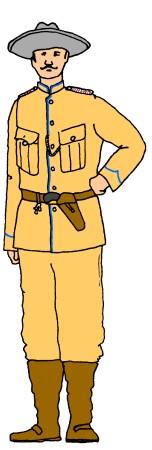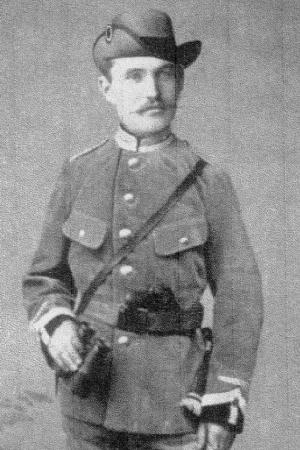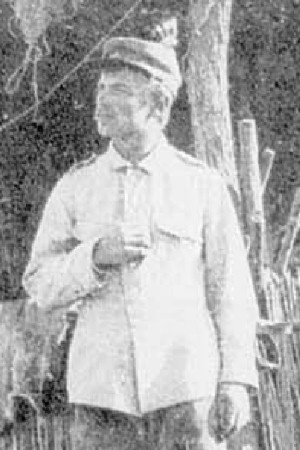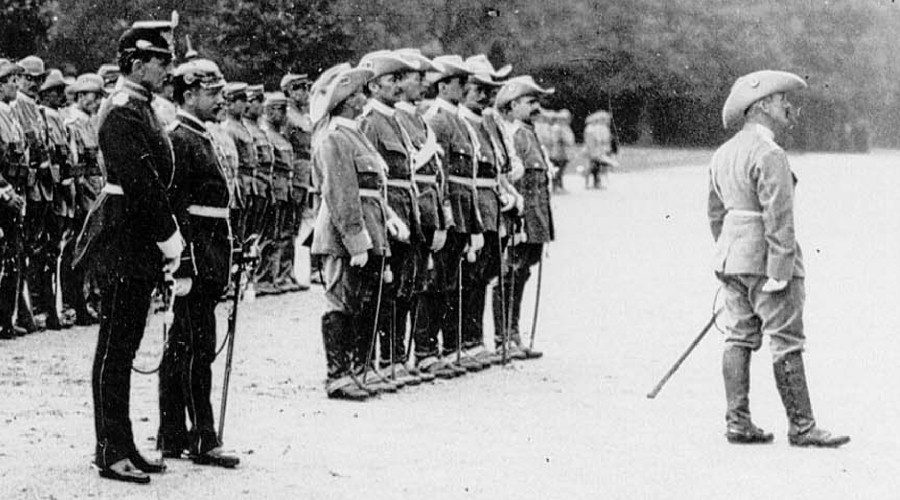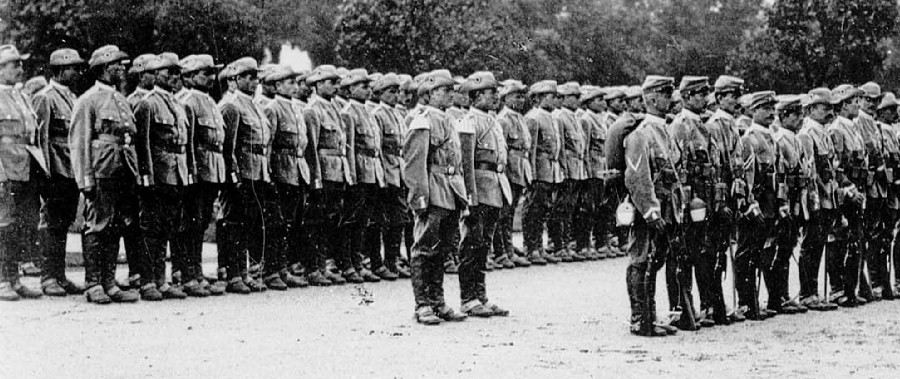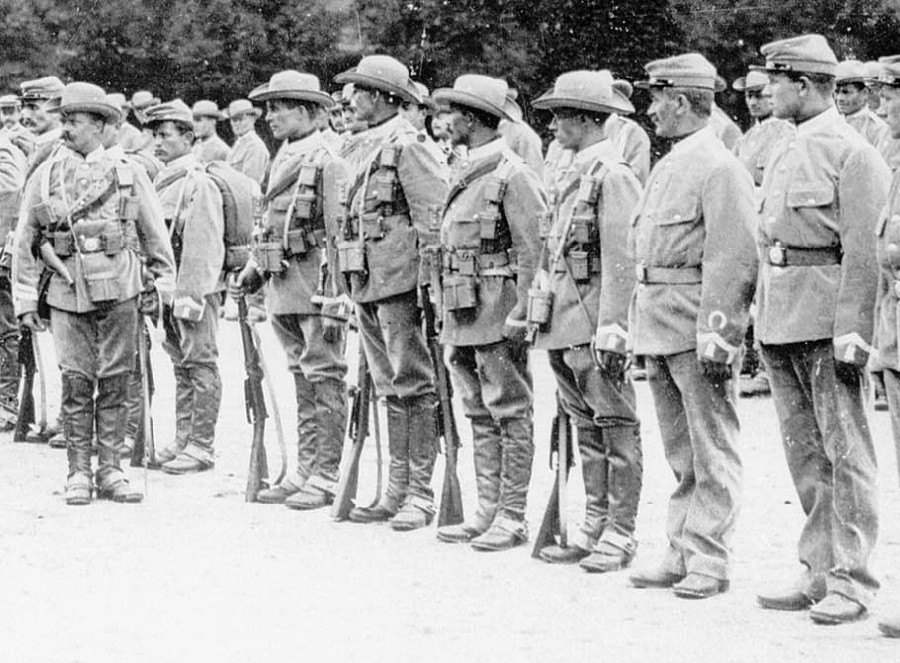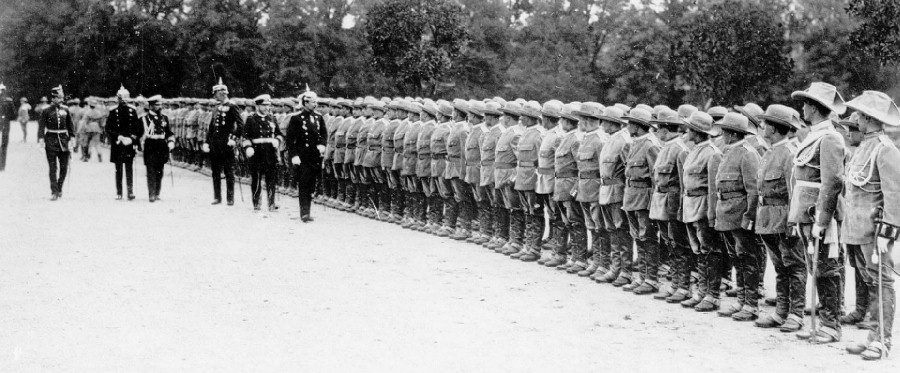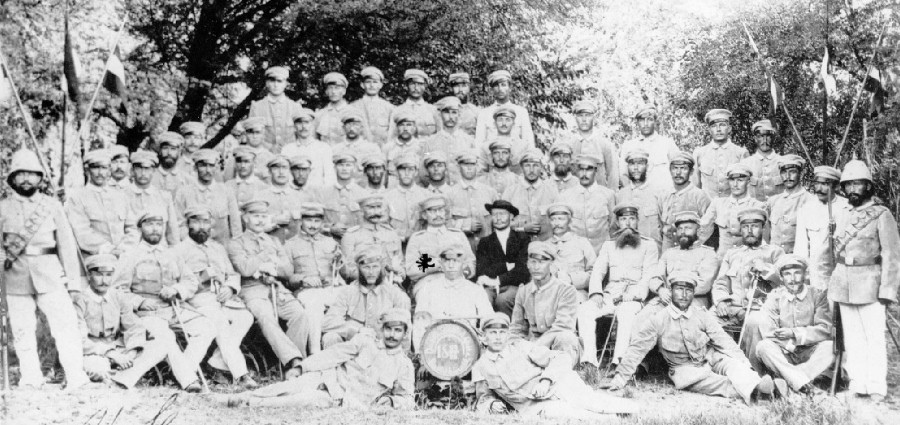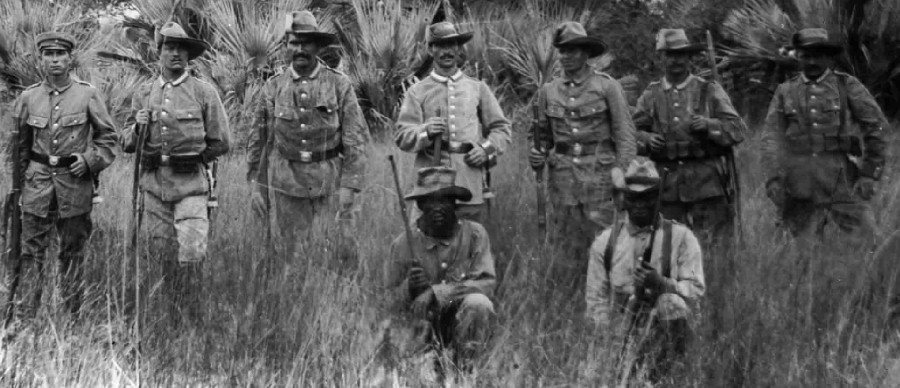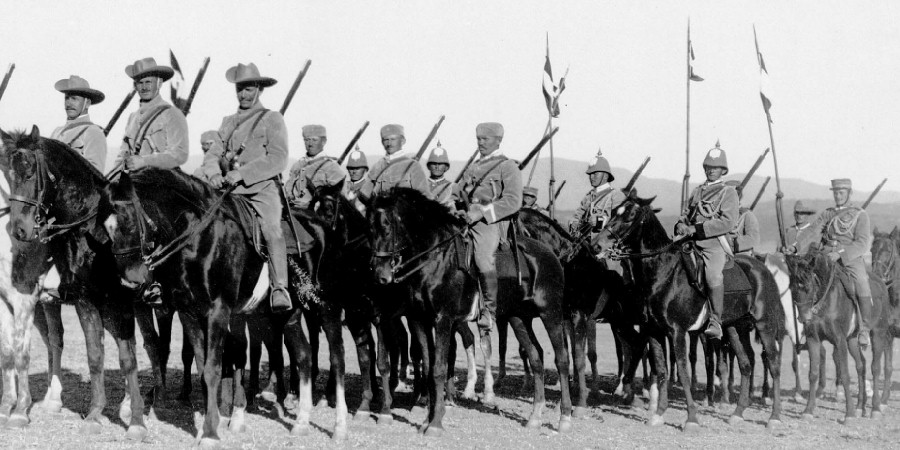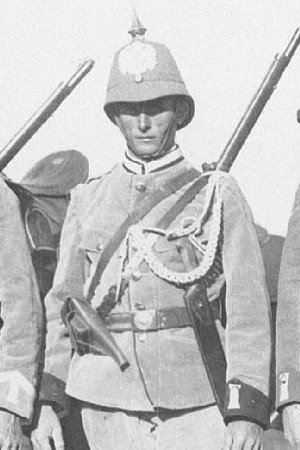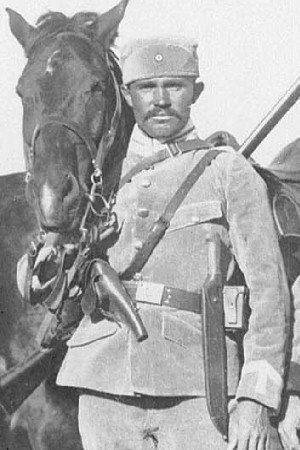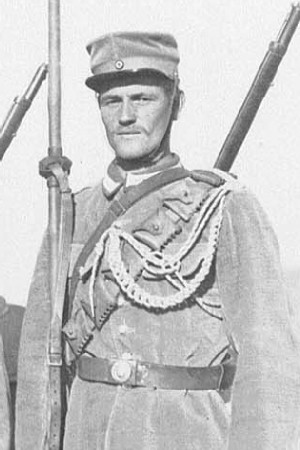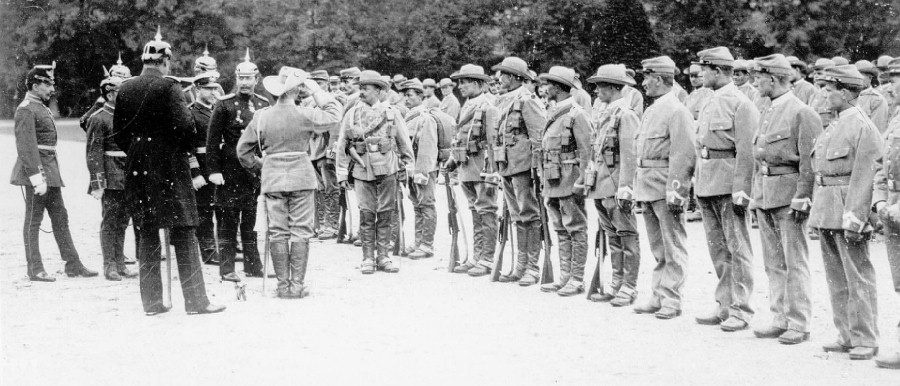1891 Corduroy Uniform
The corduroy uniform authorised on
4th June 1891 to replace the Francois-truppe uniforms now took on more of the appearance of the Prussian army
Waffenrock with a standing collar and Polish style pointed cuffs in blue. Both collar and
cuffs had white Litzen lace (metallic lace for officers). The tunic now had two breast pockets and
plain white
metal buttons replaced the horn ones on the older tunics. There were no hip
pockets. Shoulder straps
were in the style of Prussian hussars, twisted cords but in the Imperial
colours.
Stefanski describes the 1891 tunic being of
grey corduroy and Ruhl illustrates it this way too but a surviving example
in the Siebentritt collection was of a similar yellow brown to those
described for the original Francois-Truppe and later worn in a slightly
lighter shade of khaki by the Schutztruppe.
1894 Corduroy Uniform
The new corduroy authorized on
11th June 1894 had the same cut as the 1891 uniform but had stand
and fall collar.
Insignia
Rank insignia for NCOs was in the style of the Prussian army shown
as lace on the collar and cuffs and button on the collar (see
NCO Rank
Insignia Page).
Officers rank insignia was also shown in the style of the
Prussian army on white metallic lace shoulder straps with flecks of black
and red thread (see Officers Insignia Page).
Specialist insignia for musicians,
marksmen and farriers was
also in the style of the Prussian army (see
Specialist Insignia Page).
Aiguillette cords in the Imperial colours (metallic lace for officers) were
worn across the left chest on parade.
Khaki Uniform
A new khaki uniform was also introduced, based on that worn by the
Schutztruppe of East Africa in its general cut with six white metal
buttons down the front and four pleated patch pockets. It differed from the
East African tunic in that it had a standing collar and a pointed Polish style cuff but without the button or Litzen seen on the
corduroy tunic. It was piped down the front, along the upper edge of the
standing collar and around the pointed cuff in blue. Shoulder straps were as
on the corduroy uniform, twisted cords in the style of Prussian hussars in
the Imperial colours. In 1894 the
new uniform regulations gave the tunic a stand and fall collar.
Insignia
Rank Insignia for NCOs was worn in the form of chevrons with vertical
ends in white metallic lace on a blue backing. There was one chevron for an
Unteroffizier, two for a Sergeant, three for a Vizefeldwebel and four for a
Feldwebel. A Gefreiter wore a small collar button as on the corduroy
uniform.
Officers wore the same army style shoulder
straps as on the corduroy uniform. Illustrated plates by Ruhl and Hettler show officers
wearing an elaborate blue lace pattern on the cuffs of the khaki uniform. I have yet to see
period photographs showing this lace.
Specialist insignia was the same as on the
corduroy uniform.
Aiguillette cords were also worn for parade across the left chest on parade.
Greatcoat
Plain grey single breasted greatcoats were issued with six white metal
buttons down the front. They had no shoulder straps but had a blue collar
patch without Litzen. NCOs wore a vertical stripe of lace in the Imperial
colours towards the rear of the patch.
The officers greatcoat was double
breasted with two rows of six white metal buttons down the front. It
was also grey and without shoulder straps. The collar was plain grey
with no collar patches. Stefanski notes that the officers collar was
changed to blue in 1894.
Südwester
In 1891 the Südwester was retained as before in grey felt with grey ribbon
edging and hatband and a large Imperial cockade on the right side. In 1894 a blue edging and hatband were added to the
Südwester.
Tropical Helmet
Tropical
helmets were introduced for the South
West African Schutztruppe in 1891. They were tall
cork helmets covered in khaki cloth, with white metal
imperial eagles (with spread wings
for officers and
folded for other ranks), small imperial
cockades and a white metal spike with cruciform
base. These helmets were found to be impractical and were soon discarded. The Schutztruppe of South West Africa did not wear sun
helmets thereafter.
Kepi
A kepi style cap ("Käppi") was introduced in 1891 with a black leather peak and
chinstrap. It was made of matching corduroy to the uniform with a hatband
and piping in blue and a small Imperial cockade on the front. Officers wore a stripe of white metallic lace around the
hatband. The kepi was retained for a while but was being replaced with a
corduroy field cap from about 1895. Apparently the Kaiser felt that the kepi
looked too similar to those of the French army. Nevertheless photographs
from as late as 1897 show it still in use.
Field Cap
The kepi was gradually replaced with a
corduroy field cap from 1894. The new field cap was modelled on those of the
Prussian army but was peaked
for all ranks and had a blue hatband and piping with a small Imperial
cockade on the front.
Footwear
Brown leather riding boots and short ankle boots were issued. Canvas or
leather gaiters laced up down the sides were issued for use with the ankle
boots, as seen in period photographs below. Officers wore
privately purchased riding boots.
Equipment
Initially other ranks retained the
Prussian army equipment used by the Francois-truppe- a brown leather belt
with a Marine Infantry belt buckle and 1871 ammunition pouches. Officers
wore the same belt as the Marine Infantry- white metallic silk lace
with black and red stripes and a naval officers belt buckle. In action this
was probably replaced with a more practical other ranks belt.
Stefanski notes that the water bottle for other ranks was made of
thick glass covered in brown
leather with a canteen mug covering its lower half. Officers had an oxidised silver bottle covered in felt. Medical NCOs carried a larger glass
water bottle. A bread bag was also carried. The bread bag and water bottle
wear carried on straps over the shoulder. From at least 1894 a Prussian army backpack was issued
to other ranks.
The backpack and infantry ammunition pouches
were not suitable for mounted troops. At first as system of 8 pouch
bandoliers were issued to be worn across the shoulder. From 1894 a unique
new style of equipment was issued. It was an all in ne harness incorporating
belt and shoulder straps and had smaller ammunition pouches on the front of
the belt and on the shoulder straps. It can clearly be seen in the
photographs of the Kaiser inspecting the South West African troops in Berlin
(see below). This unique equipment became the prototype for later styles of
mounted equipment issued to the Schutztruppe.
Weapons
The Kar88 carbine and Gew88 rifle were standard issue for other ranks although older
weapons may also have been in limited use. The standard bayonet issued in
South West Africa with the Gew88 rifle was the S71/84. The Kar88 did not
have a bayonet mounting.
Stefanski notes that the Francois-truppe bowie knife
was retained into the early 1890s but I have yet to see period photographs
proving its use.
Officers and senior NCOs carried the Reichsrevolver 83 pistol,
although period photographs seem to show the use of privately purchased
automatic pistols was common. Officers and senior NCOs also carried the
Prussian 1889 infantry officers sword on parade.
In Prussian
cavalry lances were sent to South West Africa for use on a
trial basis. The trial was not successful and the lances were soon withdrawn
from service only seeing the light of day on special parades thereafter. The
pennant for the lance was two pointed and divided onto three horizontal
stripes of the imperial colours for other ranks. An illustration by Carl Henckel
(in "Atlas des deutschen Reichsheeres") shows the NCOs pennant to be
white with a black imperial eagle in the centre. I have yet to see a period
photograph to prove the use of such pennants but it would seem reasonable to
parallel the Prussian cavalry where the other ranks had a pennant in
Prussian colours and the NCOs had a white pennant with the Prussian eagle. |
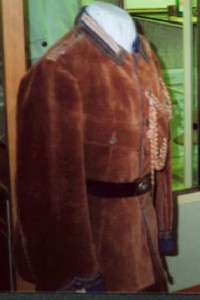
1894 NCOs Corduroy Tunic
Note the parade aiguillette cords in Imperial colours and the white
Litzen with a red central line and the metallic rank lace of an
Unteroffizier on the blue stand and fall collar and pointed Polish cuffs.
Photo ©
Traditionsverband
from the Siebentritt
Collection

Schutztruppe NCO Südwester
This example has the NCOs cockade with white metal ring and the
blue hatband and edging introduced in 1894.
(See
Südwester
Details Page)
Photo © Doppler Collection

Schutztruppe
Tropical Helmets
On the left is an example
of the short lived 1891 South West African Schutztruppe tropical helmet with a white metal spike and eagle (with spread wings for
officers) and an imperial
cockade.
On the right is an 1891
East African tropical helmet.
Photo ©
Traditionsverband
from the Siebentritt
Collection
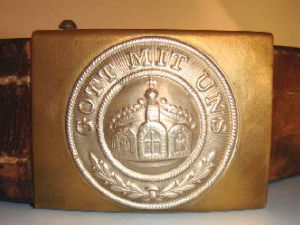
Other Ranks Naval Belt Buckle
The same belt buckle was worn by other ranks the Schutztruppe
of South West Africa.
(See
Belt Buckles)
Photo © Doppler Collection

1883 Reichsrevolver
As issued to the South West African Schutztruppe. This
example was used by the East Asian Expeditionary Corps.
(See East Asian
Pistols)
Photo © Dow Cross
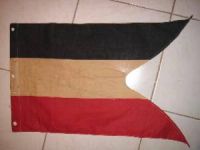
Schutztruppe Lance Pennant
As issued to the South West African Schutztruppe. Again this
example was used by the East Asian Expeditionary Corps.
(See
Mounted Equipment)
Photo © Doppler
Collection |




